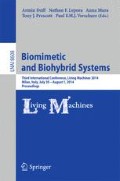Abstract
Animals are exemplary explorers and achieve great navigational performances in dynamic environments. Their robotic counterparts still have difficulties in self-localization and environment mapping tasks. Place cells, a type of cell firing at specific positions in the environment, are found in multiple areas of the hippocampal formation. Although, the functional role of these areas with a similar type of cell behavior is still not clearly distinguished. Biomimetic models of navigation have been tested in the context of computer simulations or small and controlled arenas. In this paper, we present a computational model of the hippocampal formation for robotic spatial representation within large environments. Necessary components for the formation of a cognitive map [1], such as grid and place cells, were obtained through attractor dynamics. Prediction of future hippocampal inputs was performed through self-organization. Obtained data suggests that the integration of the described components is sufficient for robotic space representation. In addition, our results suggest that dentate gyrus (DG), the hippocampal input area, integrates signals from different dorsal-ventral scales of grid cells and that spatial and sensory input are not necessarily associated in this region. Moreover, we present a mechanism for prediction of future hippocampal events based on associative learning.
Access this chapter
Tax calculation will be finalised at checkout
Purchases are for personal use only
Preview
Unable to display preview. Download preview PDF.
References
Tolman, E.C.: Cognitive maps in animals and man. Psychologival Review 55, 189–208 (1948)
O’Keefe, J., Dostrovsky, J.: The hippocampus as a spatial map. preliminary evidence from unit activity in the freely-moving rat. Brain Research 34(1), 171–175 (1971)
Hafting, T., Fyhn, M., Molden, S., Moser, M.B., Moser, E.I.: Microstructure of a spatial map in the entorhinal cortex. Nature, 801–806 (2005)
Hjorth-Simonsen, A., Jeune, B.: Origin and termination of the hippocampal perforant path in the rat studied by silver impregnation. J. Comp. Neurol, 215–231 (1972)
Engel, J.: Epilepsy: A Comprehensive Textbook in Three Volumes. Lippincott Williams & Wilkins, Philadelphia (2008)
Guanella, A., Verschure, P.F.J.: A model of grid cells based on a path integration mechanism. In: Kollias, S.D., Stafylopatis, A., Duch, W., Oja, E. (eds.) ICANN 2006. LNCS, vol. 4131, pp. 740–749. Springer, Heidelberg (2006)
Yoon, K., Buice, M.A., Barry, C., Hayman, R., Burgess, N., Fiete, I.R.: Specific evidence of low-dimensional continuous attractor dynamics in grid cells. Nat Neurosci (2013)
Alonso, A., Garcia-Austt, E.: Neuronal sources of theta rhythm in the entorhinal cortex of the rat. Exp Brain Res (1987)
Akam, T., Oren, I., Mantoan, L., Ferenczi, E., Kullmann, D.: Oscillatory dynamics in the hippocampus support dentate gyrus-ca3 coupling. Nature Neuroscience (2012)
Samsonovich, A., McNaughton, B.L.: Attractor map model of the hippocampus. J. Neurosci. 17(15) (1997)
Lallee, S., Dominey, P.F.: Multi-modal convergence maps: From body schema and self-representation to mental imagery. Adaptive Behavior (2013)
Bermudez, S.: http://sergibermudez.blogspot.com.es/p/ants-downloads.html
Metta, G., Fitzpatrick, L., Natale, P., Natale, L.: Yarp: yet another robot platform. Journal on Advanced Robotics Systems (Special Issue on Software Development and Integration in Robotics) (2006)
Rennó-Costa, C., Lisman, J.E., Verschure, P.F.M.J.: The mechanism of rate remapping in the dentate gyrus. Neuron 68(6), 1051–1058 (2010)
Author information
Authors and Affiliations
Editor information
Editors and Affiliations
Rights and permissions
Copyright information
© 2014 Springer International Publishing Switzerland
About this paper
Cite this paper
Pata, D.S., Escuredo, A., Lallée, S., Verschure, P.F.M.J. (2014). Hippocampal Based Model Reveals the Distinct Roles of Dentate Gyrus and CA3 during Robotic Spatial Navigation. In: Duff, A., Lepora, N.F., Mura, A., Prescott, T.J., Verschure, P.F.M.J. (eds) Biomimetic and Biohybrid Systems. Living Machines 2014. Lecture Notes in Computer Science(), vol 8608. Springer, Cham. https://doi.org/10.1007/978-3-319-09435-9_24
Download citation
DOI: https://doi.org/10.1007/978-3-319-09435-9_24
Publisher Name: Springer, Cham
Print ISBN: 978-3-319-09434-2
Online ISBN: 978-3-319-09435-9
eBook Packages: Computer ScienceComputer Science (R0)

